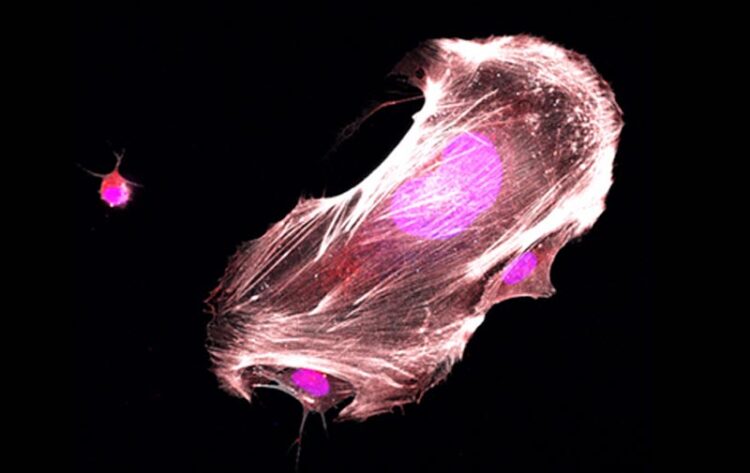Stopping a rare childhood cancer in its tracks

Scientists discovered targeting a protein called ETV6 can turn Ewing sarcoma cancer cells back to normal-looking and -behaving connective tissue cells, as seen above.
Credit: Vakoc lab/Cold Spring Harbor Laboratory
Scientists at Cold Spring Harbor Laboratory (CSHL) have discovered a new drug target for Ewing sarcoma, a rare kind of cancer usually diagnosed in children and young adults. Their experiments show that the cells causing this cancer can essentially be reprogrammed with the flick of a genetic switch.
Shutting down a single protein forces the cancer cells to take on a new identity and behave like normal connective tissue cells, a dramatic change that reins in their growth. This discovery suggests researchers may be able to stop Ewing sarcoma by developing a drug that blocks the protein known as ETV6.
Ewing sarcoma causes tumors to grow in bones or the soft tissues surrounding them. Once a tumor begins to spread to other parts of the body, it can be very difficult to halt the disease’s progression. Even for patients with positive outcomes, treating Ewing sarcoma often causes toxic side effects. New treatments are badly needed, says CSHL Professor Christopher Vakoc, who led the research on ETV6.
Vakoc and his colleagues became excited about ETV6 when their experiments revealed that Ewing sarcoma cells seem uniquely dependent on this protein. “This protein is present in all cells. But when you perturb the protein, most normal cells don’t care,” he says. “The process by which the sarcoma forms turns this ETV6 molecule—this relatively innocuous, harmless protein that isn’t doing very much—into something that’s now controlling a life-death decision of the tumor cell.”
Postdoctoral researcher Yuan Gao works in Vakoc’s lab. When Gao blocked ETV6 in Ewing sarcoma cells grown in the lab, she witnessed a dramatic transformation. “The sarcoma cell reverts back into being a normal cell again,” she says. “The shape of the cell changes. The behavior of the cells changes. A lot of the cells will arrest their growth. It’s really an explosive effect.”
Vakoc and Gao hope other researchers will use what they’ve learned to begin exploring potential therapies for Ewing sarcoma that work by switching off ETV6. They say their biochemical analyses, which identify specific spots in the ETV6 protein that are key to its function in cancer cells, could help guide drug development. Because their experiments have shown that most cells are unaffected by the loss of ETV6 activity, they are optimistic that such a drug might be able to eliminate cancer cells while causing few, if any, side effects.
Journal: Nature Cell Biology
DOI: 10.1038/s41556-022-01060-1
Article Title: ETV6 dependency in Ewing sarcoma by antagonism of EWS-FLI1-mediated enhancer activation
Article Publication Date: 19-Jan-2023
Media Contact
Samuel Diamond
Cold Spring Harbor Laboratory
diamond@cshl.edu
Office: 5163675055
All latest news from the category: Life Sciences and Chemistry
Articles and reports from the Life Sciences and chemistry area deal with applied and basic research into modern biology, chemistry and human medicine.
Valuable information can be found on a range of life sciences fields including bacteriology, biochemistry, bionics, bioinformatics, biophysics, biotechnology, genetics, geobotany, human biology, marine biology, microbiology, molecular biology, cellular biology, zoology, bioinorganic chemistry, microchemistry and environmental chemistry.
Newest articles

NASA: Mystery of life’s handedness deepens
The mystery of why life uses molecules with specific orientations has deepened with a NASA-funded discovery that RNA — a key molecule thought to have potentially held the instructions for…

What are the effects of historic lithium mining on water quality?
Study reveals low levels of common contaminants but high levels of other elements in waters associated with an abandoned lithium mine. Lithium ore and mining waste from a historic lithium…

Quantum-inspired design boosts efficiency of heat-to-electricity conversion
Rice engineers take unconventional route to improving thermophotovoltaic systems. Researchers at Rice University have found a new way to improve a key element of thermophotovoltaic (TPV) systems, which convert heat…



